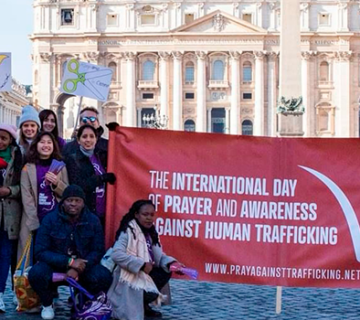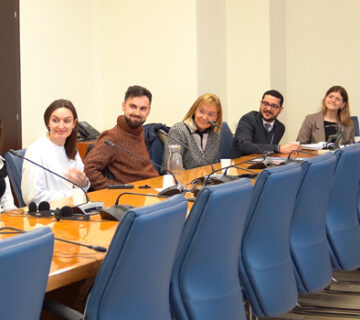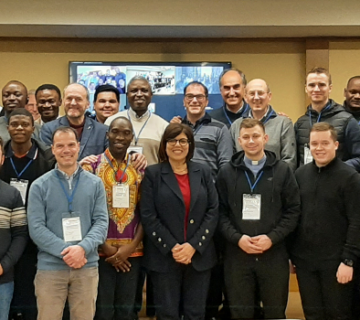 It was an unpublished account revealing Mary’s strength of peace, in action in the history of peoples, in moments of grave suffering, that Prof. Tommaso Sorgi, Director of the Igino Giordani Centre in Rome, presented to the Marian Congress. He showed that the “Rosary is an effective weapon even in the political arena”. To give an example, he spoke of what happened just a few years ago. Half way through the 1980s, the bishops in the Philippines launched a prayer campaign for their own conversion, that seemed necessary to obtain from heaven the liberation from the Marcos’ dictatorship. Five million Filipinos adhered to the campaign and the world saw a complete turnaround of events: “The dictator fled into exile and the revolution of the Rosary liberated the people without bloodshed”.
It was an unpublished account revealing Mary’s strength of peace, in action in the history of peoples, in moments of grave suffering, that Prof. Tommaso Sorgi, Director of the Igino Giordani Centre in Rome, presented to the Marian Congress. He showed that the “Rosary is an effective weapon even in the political arena”. To give an example, he spoke of what happened just a few years ago. Half way through the 1980s, the bishops in the Philippines launched a prayer campaign for their own conversion, that seemed necessary to obtain from heaven the liberation from the Marcos’ dictatorship. Five million Filipinos adhered to the campaign and the world saw a complete turnaround of events: “The dictator fled into exile and the revolution of the Rosary liberated the people without bloodshed”.
It was the Magnificat in action: Mary magnified the Lord who “scattered the proud and brought down the powerful from their thrones…”. The Magnificat, therefore, “can be assumed as the model for political action”. This was the perspective opened up by prof. Sorgi in these times when there is an urgency to “bring down the fundamental categories of power”. He proposed “the Magnificat as the social ‘magna charta’” But the regality of Mary, he underlined, is a “regality of love”, a “maternal regality”. Politics can therefore assume “the warmth of a service of love … the soul it so badly needs”.
Following the talk given by prof. Sorgi, prof. Adam Biela, an academic and politician, shared in his testimony how prayer is a source of inspiration and strength in his political commitment to go against the current in favour of a true development of his country
 “The great civilised and democratic countries have opted for war as the means for resolving conflict.” This was the strong message given by prof. Andrea Riccardi, founder of the St Egidio Community, in his address on the second day of the International Marian Congress. In his talk he poses a question which “makes everyone uneasy”: “Will war once again be the future of the world?” And here, prof. Riccardi highlights the strength of peace emanating from femininity, illustrating that Mary, at the foot of the cross, is the one who, though “overcome” by the violence of the death of her Son, “conceals in her tears the strength of life and hope” and is “unbending in the face of the logic of conquered and conqueror, friend and foe.” “The mystery of faith that we see in Mary,” prof. Riccardi continues, “is that strength can be found in weakness, lowliness can be found in greatness, life can be present in a body destined to die.” Today, “Mary represents the strength of peace in the midst of war”.
“The great civilised and democratic countries have opted for war as the means for resolving conflict.” This was the strong message given by prof. Andrea Riccardi, founder of the St Egidio Community, in his address on the second day of the International Marian Congress. In his talk he poses a question which “makes everyone uneasy”: “Will war once again be the future of the world?” And here, prof. Riccardi highlights the strength of peace emanating from femininity, illustrating that Mary, at the foot of the cross, is the one who, though “overcome” by the violence of the death of her Son, “conceals in her tears the strength of life and hope” and is “unbending in the face of the logic of conquered and conqueror, friend and foe.” “The mystery of faith that we see in Mary,” prof. Riccardi continues, “is that strength can be found in weakness, lowliness can be found in greatness, life can be present in a body destined to die.” Today, “Mary represents the strength of peace in the midst of war”.
“A mother’s concern” for the needs of others, “even though unspoken”, as shown by Mary at the “Marriage Feast of Cana”, was the focus of a talk given by Anna Pelli. It was a reflection on this Gospel episode, one of the Mysteries of Light that was deepened during the Marian Congress.
This Gospel episode was reflected in an experience recounted by Carmen and her daughter, Maricel, from the Philippines. Their family had undergone many sufferings: financial difficulties, alcohol, drugs, constant arguments and the repercussions all this had on each of the eight children. They lived in a shack on the outskirts of Manila. Theirs was a story of resurrection starting from the discovery of God’s love and of Mary as a model to imitate. Carmen, the mother, shared how her life changed when she came into contact with the Bukas Palad Social Centre, run by the Focolare Movement. She was able to start again with her husband, who for years had been drinking and gambling. Maricel shared her experience of giving up the life of drugs she had led for seven years, finding the strength to forgive her father who, during their estrangement, had changed so dramatically. Maricel looked after him in the last days of his life. It was a miracle of love which flowed on to other poor families in their district through the Bukas Palad centre where Carmen and Maricel now dedicate their time as social workers.
 The artistic contribution of today’s program was truly extraordinary. It was focussed on this Mystery of Light, the “Marriage Feast of Cana”, leading everyone into the very heart of the Gospel. The choreography “Do Whatever He Tells You” by Marinel Stefanescu illustrated not so much the wedding feast but rather the profound meaning of the miracle of the water changing into wine, symbol of the blood which Jesus himself would shed in order to work the greatest miracle of all: the Resurrection.
The artistic contribution of today’s program was truly extraordinary. It was focussed on this Mystery of Light, the “Marriage Feast of Cana”, leading everyone into the very heart of the Gospel. The choreography “Do Whatever He Tells You” by Marinel Stefanescu illustrated not so much the wedding feast but rather the profound meaning of the miracle of the water changing into wine, symbol of the blood which Jesus himself would shed in order to work the greatest miracle of all: the Resurrection.
Another moment in the intense program of the Marian Congress was the contribution given by the new charisms on the vital understanding of Mary and the Rosary. There was a round table session composed of representatives of various movements and ecclesial communities including: Catholic Charismatic Renewal, St Egidio Community, Cursillos, Schoenstatt and the Legionaires of Christ.
“I enjoyed the sharing of testimonies by representatives of the different charisms; it was as if we could see Mary alive and present in each one in the heart of the Church,” wrote a person from Paraguay who had followed the congress through the Internet. And a participant from Argentina commented: “The series of testimonies shared by exponents of various movements was a witness to the variety of gifts which make the Church beautiful.”
A particularly profound testimony was that shared by Fr Pasquale Foresi, co-founder of the Focolare Movement and the first focolarino to be ordained a priest. What emerged through his talk was a renewed priesthood, a Marian priesthood, and the fruitfulness of a life lived in the development of the Focolare Movement.


 Italiano
Italiano Español
Español Français
Français Português
Português


